If you’re looking for help to identify black birds with white bellies, this will be the best article you read today.
In this post, you will find photos, identification info, calls, and all the fun facts you need.
Examples of black birds with white bellies include the dark-eyed junco, black phoebe, king penguin, Atlantic puffin, razorbill, black-and-white warbler, hairy woodpecker, and many others.
The black and white colors of bird plumage come from a pigment called melanin.
Black feathers have lots of melanin; white feathers have a lack of pigmentation and almost have no melanin.
Here are 30 of the most interesting ones.
Table of Contents
Black Birds With White Bellies
Dark-eyed Junco
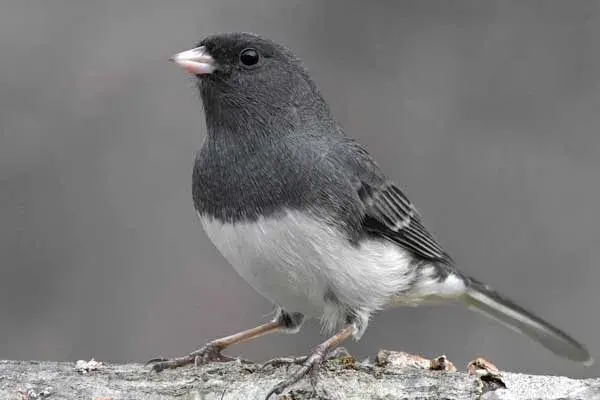
- Scientific Name: Junco hyemalis
- Lifespan: 3-11 years
- Wingspan: 7.1-9.8 in
Dark-eyed juncos are small songbirds that belong to a group of New World sparrows.
There are around 15 recognized subspecies that look similar and make taxonomists’ lives a misery.
Dark-eyed juncos can be recognized by their rounded heads, short beaks, and fairly long tails.
They also have black plumage, dark heads, white underbellies, and pale beaks.
Dark-eyed juncos are one of the most common birds of North America that can be seen around woodlands, brushy fields, parks, and thickets.
The song of male dark-eyed juncos is a strong musical trill that lasts around two seconds and consists of up to 20 notes.
Both sexes usually have a quieter song that includes different whistles, trills, and warbles. Their calls include high-pitched “chip” and “tick” sounds.
They often forage while hopping and running on the ground and might even scratch the ground/snow with their feet in pursuit of food.
Dark-eyed juncos are nicknamed “snowbirds” because they’re commonly sighted during winter.
They are omnivores that have a diet consisting of seeds and some insects in summer.
Ring-necked Duck

- Scientific Name: Aythya collaris
- Lifespan: up to 20 years
- Wingspan: 24.6 in
These small diving ducks are found in North America, around freshwater ponds and lakes.
They resemble tufted ducks, their European relatives; to identify ring-necked ducks, look for the species’ distinctive, peaked heads.
Male ring-necked ducks are bold black with white chests and bellies, grayish-white sides, and yellow eyes.
Females are grayish-brown with white patches near their beaks, and white eyerings; both sexes also have white bands on their gray bills.
Ring-necked ducks can be vocal and will make a series of short barks, grunts, and high “peeping” calls (in females).
These black and white ducks breed in wooded lakes and ponds of northern parts of Canada and the USA.
They pair only during the reproductive season, build bowl-shaped nests on the water in dense vegetation, and lay 8-10 eggs.
After that, ring-necked ducks migrate to winter in southern North American ponds, lakes, rivers, and bays.
Ring-necked ducks are omnivores that forage by dabbling or diving and have a diet consisting of insects, earthworms, snails, and plants.
They were named after the hard-to-spot collar on their black necks.
Black-billed Magpie

- Scientific Name: Pica hudsonia
- Lifespan: up to 9 years
- Wingspan: 24 in
Black-billed magpies are large and conspicuous birds of western North America.
They are also known as American magpies and can be often seen sitting on fence posts and road signs or flapping across rangelands.
Black-billed magpies are easy to recognize by their black heads, chests, backs, and tails, white bellies and shoulders, and blue-green iridescent patches in the wings and tails.
As the name suggests, they have thick and slightly curved black beaks and very long, iridescent green tails.
Although a rare bird feature, black-billed magpies can locate food using their sense of smell. They are omnivorous and feed on insects, carrion, rodents, eggs, young of other birds, and sometimes small snakes.
Black-billed magpies are very social and extremely noisy birds, living in groups of 5-10 individuals.
Listen for their most common “ka-ka-ka” alarm call and other tweets, coos, squawks, purrs, and shrills.
One of the most interesting behaviors among them is the so-called “funeral.”
When one magpie discovers a dead magpie, it will call other magpies. Groups of over 40 magpies might gather and spend 10 to 15 minutes around the cadaver before dispersing and flying off in silence.
They mate for life and it might take them up to 40 days to construct a single nest.
Black-billed magpies can be often seen around animals, picking ticks from the backs of large mammals such as deer and moose.
These black birds with white bellies are also permanent residents of Colorado; read about other birds found in the state.
Black Phoebe

- Scientific Name: Sayornis nigricans
- Lifespan: up to 8 years
- Wingspan: 10.5-11 in
Black phoebes are small flycatchers with predominantly black plumage and white parts on their bellies and undertail coverts.
Identify them by their characteristic “tail-wagging” motion where they lower the tails and fan out the tails’ feathers.
Sexes look similar and have a repeated “tee-hee, tee ho” song.
Black phoebes weigh as little as half an ounce and have a wingspan of just 10.5 inches.
They are common across the western USA and breed from southwest Oregon and California south through Central and South America.
Look for them around open areas near lakes, streams, and ponds, as well as agricultural areas and city parks.
Black phoebes are carnivores that mostly feed on insects, but might occasionally catch fish.
They will use mud to build their cup-shaped nests, placing them often against walls, overhangs, and bridges.
Spotted Towhee
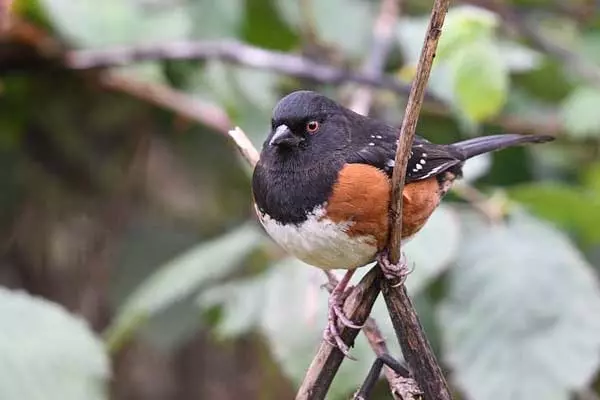
- Scientific Name: Pipilo maculatus
- Lifespan: up to 12 years
- Wingspan: 11 in
These large, striking, and long-tailed sparrows are commonly found in western North America.
They breed in north-western parts of the continent, they are present year-round in states like Washington, Oregon, Utah, California, and Arizona, and migrate to winter in southern parts of the USA and northern parts of Mexico.
These songbirds inhabit dry upland forests, open forests, brushy fields, and chaparrals.
Recognize spotted towhees by their black hoods, black backs, and black wings that are speckled with white spots, white bellies and tail tips, and rufous flanks.
They also have bright red eyes and dull pink legs.
Females are similar to males but are dark brown and gray instead of black.
Spotted towhees love to nest on the ground or low in bushes.
They will often jump forward with their heads and tails up and kick their legs backward. If you look closely, you might spot one hopping along the ground, scraping away leaf litter, and looking for insects, beetles, spiders, acorns, seeds oats, and berries.
They are also common around bird feeders so you might be lucky to find a spotted towhee around your backyard.
King Penguin
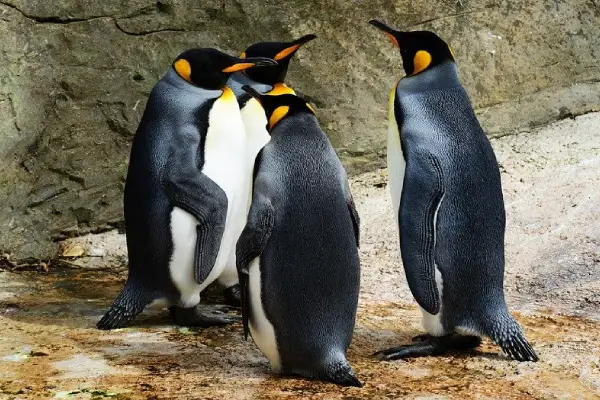
- Scientific Name: Aptenodytes patagonicus
- Lifespan: up to 26 years in the wild
- Wingspan: n/a
King penguins are the second largest penguin species, after the Emperor penguins.
They can weigh from 21 to 40 pounds and stand 28-39 inches tall.
Males tend to be larger than females.
Adult king penguins are black birds with white bellies; they also have some orange-yellow on their heads, necks, and bills.
They inhabit Subantarctic islands and peninsulas and prefer beaches and valleys of level ground or gentle slopes, free of snow and ice, and accessible to the sea.
King penguins are omnivores and have a diet consisting of squid, kill, and lanternfish. They forage by diving and can go deeper than 1,000 feet underwater!
These highly social birds form huge colonies during the breeding season, with some including over 200,000 birds.
King penguins are monogamous but have a fidelity rate of less than 30%. This is most likely due to their very long breeding cycle that lasts from 14 to 16 months.
They do not build nests but stand upright and place their eggs on top of their feet while they incubate them with loose skin called brood patch; partners take turns in incubating the eggs.
Juvenile Magnificent Frigatebird
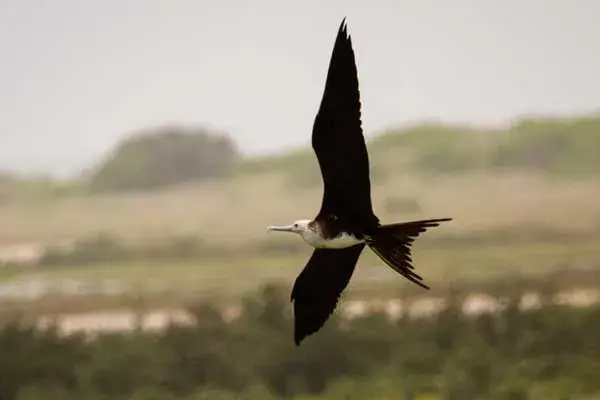
- Scientific Name: Fregata magnificens
- Lifespan: 14-30 years
- Wingspan: 85-96 in
Magnificent frigatebirds are the largest species of frigatebird in the world.
They measure almost 4 feet in length, weigh 2.4-3.5 pounds, and span almost 8 feet across the wings.
In North America, they are most commonly found in the Gulf of Mexico, around states like Texas and Florida.
They were named magnificent due to their striking appearance and behavior, these black birds can be easily recognized by their size, long pointed wings, and long deeply forked tails.
Female magnificent frigatebirds are black with white breasts and bellies, immatures are black with white heads and underparts, and the males are black with scarlet throat pouches they inflate like balloons during the breeding season.
They mostly feed on fish taken in flight from the ocean’s surface and their favorite food is flying fish, tuna, and squid.
Just like their cousins, great frigatebirds, magnificent frigatebirds will also harass and steal fish from other animals. This is known as kleptoparasitism.
Despite their massive wingspans, these birds can’t land on water as their feathers aren’t waterproof and they would most likely drown.
Great Black-backed Gull

- Scientific Name: Larus marinus
- Lifespan: up to 27 years
- Wingspan: 59-66.9 in
Great black-backed gulls are the largest gulls in Florida that weigh over 5 pounds and have a wingspan of up to 5 ft 7 inches.
They are nicknamed “kings of the Atlantic waterfront” and have large and powerful yellow beaks measuring 2.1-2.85 inches.
Great black-backed gulls also have black-gray wings and backs, white underparts, heads, and necks, and pink legs.
Identify them by their deeper voice than other gulls and their “laughing” “kaa-ga-ga” calls.
Great black-backed gulls are very aggressive hunters, pirates, and scavengers.
Because of their enormous size and omnivorous feeding habits, these birds will prey on other birds during the nesting season.
Great black-backed gulls also feed on carrion, fish, mollusks, crustaceans, marine worms, insects, rodents, and berries.
Great black-backed gulls were hunted for their feathers that were used to make hats. As a result, this species got eradicated from large parts of its range.
Today, however, due to their improved adaptability to humans, their populations have increased in numbers.
In fact, they became so widespread today that in some areas people consider them pests.
Hooded Merganser

- Scientific Name: Lophodytes cucullatus
- Lifespan: 11-12 years in the wild
- Wingspan: 23.6-26 in
Hooded mergansers are small diving ducks with a striking appearance.
Their scientific name perfectly describes them: “lophos” means “crest” and “dutes” means “diver”.
Male hooded mergansers have black necks and backs, white chests, breasts, and bellies; they also have large black heads with prominent white patches and chestnut flanks.
Females are gray and brown; both sexes have crests that they can raise or lower.
They are native to North America and can be commonly found around inland lakes and ponds from spring to fall.
They migrate to their wintering grounds on the east and west coasts of the USA; they are usually in pairs or small flocks, but might occasionally mix with other ducks.
Identify hooded mergansers by their distinctive, rolling, frog-like “crrroo” calls.
They are omnivores and feed on small fish, crawfish, aquatic insects, and some vegetation.
They hunt by diving and use their sight when underwater and can stay there for up to 2 minutes while chasing the prey!
They have a third eyelid called a “nictitating membrane” that is transparent and allows them to see when submerged with no injury to the eyes; camels also have such eyelids.
Hooded mergansers are monogamous for a season and will stay together until the female builds the nest and lays the eggs.
Males then leave the females to incubate their 7-15 whitish eggs and rear the young alone.
Hairy Woodpecker
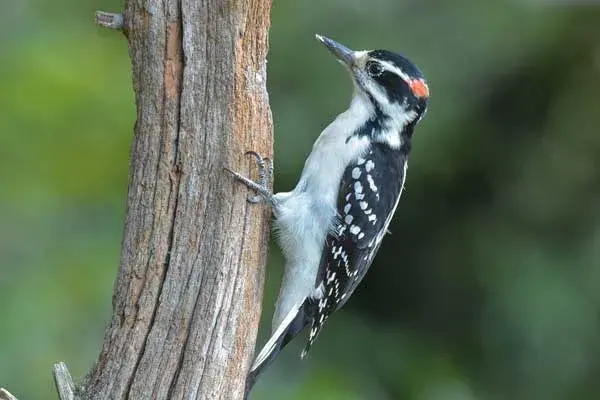
- Scientific Name: Leuconotopicus villosus
- Lifespan: up to 15 years
- Wingspan: 13-16 in
Hairy woodpeckers are medium-sized woodpeckers with black and white plumage; they have black wings with white patches, white bellies, two white stripes on their heads, and a large white patch down the center of their black backs.
There are 17 recognized subspecies of these birds.
Hairy woodpeckers are found in mature deciduous forests of most of North and Central America, year-round.
They have a short and sharp “peek” call that is very similar to that of downy woodpeckers.
Those two contrastingly black and white woodpeckers resemble – the main difference between the two is the smaller size and shorter beaks of downy woodpeckers.
They forage along trunks and main branches of large trees and got the name “hairy” because of the thread-like white feathers in the middle of their backs.
Similar to other woodpeckers, hairy woodpeckers also play an important role in the ecosystem as they make nesting holes for other animals and eat the insects that destroy trees, saving forests as a result. They also consume some berries, seeds, and nuts.
Thick bones and cartilage that act as a shock absorber allow them to hammer at tree back without injuries, and a tongue twice the size of the beak helps probe trees for insects.
Eurasian Magpie
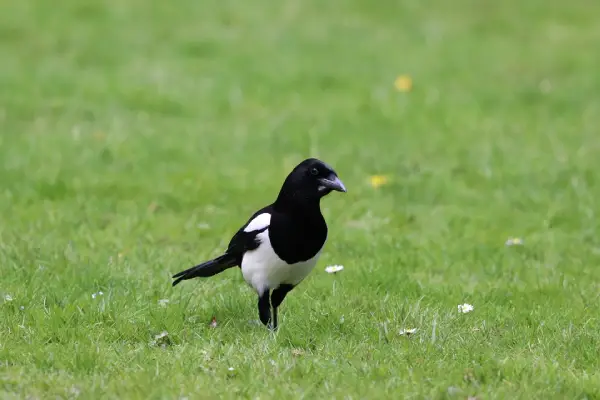
- Scientific Name: Pica pica
- Lifespan: 2-3 years in the wild
- Wingspan: 20-24 in
Eurasian magpies, also known as common magpies, are extremely intelligent birds commonly found around the open countryside with scattered trees of Europe, Asia, and northwestern Africa.
Eurasian magpies have glossy black heads, necks, and breasts, iridescent blue-green wings and tails, and the white color of their bellies and scapulars (shoulder feathers).
Their most common call is a repeated “chac-chac“.
These magpies are so intelligent that they can use tools, imitate human speech, grieve, play games, work in teams, and recognize themselves in a reflection (the mirror test).
The only non-human species that have passed the mirror test are the great apes, dolphins, elephants, and magpies.
These birds are omnivores that feed on young birds and eggs, small mammals, insects, carrion, acorns, and grain.
Eurasian magpies are monogamous and breed around spring.
They will have a clutch of 3-10 pale blue-green eggs with brown marks that females incubate while the males feed them.
Eastern Kingbird
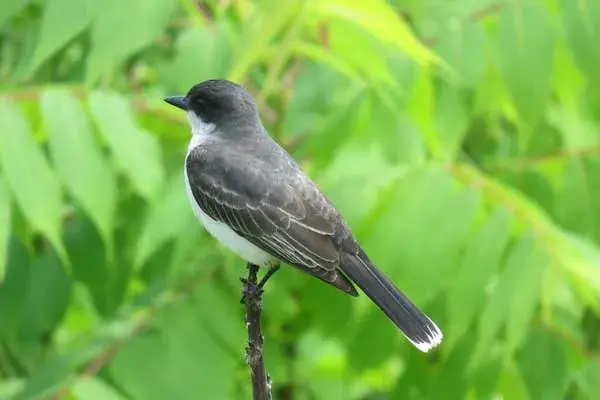
- Scientific Name: Tyrannus tyrannus
- Lifespan: up to 11 years
- Wingspan: 13-15 in
Eastern kingbirds are large flycatchers found in North, Central, and South America.
They inhabit the open country, farms, and fields; areas that have bushes and scattered trees where they can perch while foraging for insects.
The name “kingbird” comes from the birds’ crowns.
Eastern kingbirds have dark gray-black plumage, white underparts, dark caps on their heads, and white bands at the tips of their tails.
They breed across entire North America, nest in trees and shrubs, lay 2-5 cream-colored eggs with reddish spots, and migrate to winter in South America, primarily northwestern Amazonia.
During their breeding season, they are very aggressive and territorial and will chase away any bird that enters their territories, including large ones like hawks and crows.
Eastern kingbirds have a song that consists of high, sputtering notes; their calls include the high-pitched “kit-kit” and “dzee-dzee” sounds.
They will often perch on wires, watch for large insects, and make quick flights to snatch them. Eastern kingbirds also feed on berries and fruit, mainly during winter.
Tufted Duck

- Scientific Name: Aythya fuligula
- Lifespan: n/a
- Wingspan: 27.5 in
Tufted ducks are the Old World counterparts of the North American ring-necked ducks.
These small diving ducks are commonly found around marshes, lakes, ponds, coastal lagoons, and shorelines of Europe and Asia; they might also winter along both coasts of the USA and Canada.
They were named after the tufts males have on their heads.
Male tufted ducks are all-black and have white bellies and flanks and blue-gray beaks.
Females are mostly brown and have paler flanks, dark breasts, white bellies, and gray beaks.
People sometimes mistake tufted ducks for greater scaups and lesser scaups but those 2 species do not have tufts on their heads and have different calls.
Listen for the harsh “karr” calls female tufted ducks make and the whistling “wit-oo” courting calls of the males.
These black ducks with white bellies are omnivores: they find food primarily by diving and have a diet consisting of plants, mollusks, and insects.
Black-necked Stilt
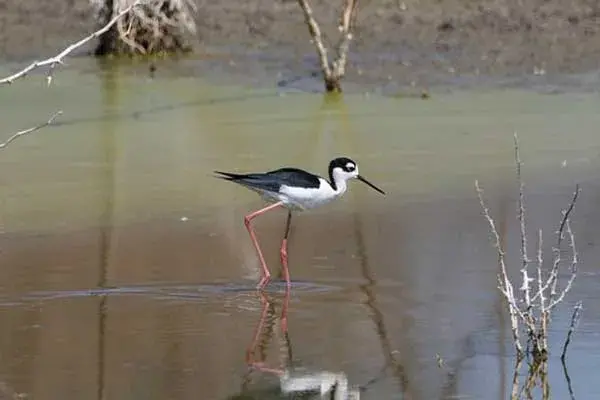
- Scientific Name: Himantopus mexicanus
- Lifespan: 12-20 years
- Wingspan: 28-30 in
Black-necked stilts are delicately-looking black and white shorebirds.
They are commonly found in North, Central, and South America; there is an isolated population in Hawaii.
Black-necked stilts have striking black backs and wings, white bellies, thin black bills, and long rosy pinkish legs.
Females resemble males but have brownish backs.
Black-necked stilts got their Latin name as a reference to their long and thin legs.
These birds can be found along the edges of shallow water in the open country; they are absent from much of the eastern USA.
They forage by wading in shallow waters in search of marine invertebrates and insects.
Black-necked stilts are gregarious and often roost in small groups; when foraging, they tend to spread out.
If you are trying to hear them, listen for a short, squeaky, repeated “yip-yip-yip” call.
Females will lay 3-5 eggs and both partners will take turns and incubate the eggs. After hatching, the young can be seen swimming within a couple of hours.
Greater Scaup

- Scientific Name: Aythya marila
- Lifespan: up to 20 years
- Wingspan: 28-33 in
Greater scaups are medium-sized diving ducks with round heads and yellow eyes.
In North America, they are also known as “bluebills” due to their conspicuous dull blue bills with black tips.
Male greater scaups have black breasts, black heads with a green gloss, white stripes on wings, and white bellies and sides.
Females are brown overall with white wing markings similar to those that males have.
Identify male greater scaups by their soft nasal courting whistles and females by their raspy “arr-arr” alarm calls.
In North America, they breed in shallow lakes and ponds of northern Canada and Alaska and winter along the coasts of North America, shores of the Great Lakes, and in the Gulf of Mexico.
Greater scaups are monogamous and females will lay 6-9 olive-brown eggs.
During winter, they will form large groups consisting of hundreds and thousands of birds.
Greater scaups are omnivores and feed on insects, mollusks, crustaceans, plants, and seeds.
They are great at diving and can go up to 23 feet below the surface.
Read More: More examples of stunning ducks that have blue-colored bills
Razorbill

- Scientific Name: Alca torda
- Lifespan: 13 years
- Wingspan: 23-26 in
Razorbills, also known as razor-billed auks and lesser auks, are the northern hemisphere’s ecological equivalents of penguins.
These short (17 inches long) seabirds have short wings and thick and blunt beaks.
Razorbills have white bellies and black heads, necks, backs, and feet.
Their black beaks also have a white line in the middle.
Identify razorbills by their low guttural or croaking “urr” sounds.
In North America, they breed in colonies on rocky islands, along the coasts of eastern Canada, and in a few spots in Maine.
They winter on the ocean or relatively close to the shores, from areas near their breeding grounds to as far south as Virginia on the US coast.
The largest population is found in Iceland, around 50% of the estimated 1 million razorbills alive today.
The species is monogamous and pairs mate for life. They lay one cream-colored egg with brown spots and both parents take turns incubating it.
Razorbills forage by diving (up to 330 feet) and feed on fish, some crustaceans, or other small marine creatures.
Brown Creeper

- Scientific Name: Certhia americana
- Lifespan: 6.7–7.9 in
- Wingspan: 4.7–5.5 in
Brown creepers are extremely small songbirds found throughout North America.
They are the only members of the treecreeper family called Certhiidae found in the USA.
These birds are so small that they can weigh as little as 0.2 ounces!
Identify brown creepers by their brown-black upperparts with light spots, white underparts, thin slightly downcurved beaks, and broad stripes over the eye (supercilium); their bellies are white with some reddish/brown.
Such plumage camouflages these tiny birds well and makes them look like a piece of bark from distance.
Only the males sing and the song consists of high, thin notes that sound like “pee-pee-willow-wee“. Brown creepers’ call is a high-pitched “swee“.
They breed in coniferous forests, typically starting in April, and lay 3-7 eggs that both parents raise.
They are omnivores that mainly feed on insects, spiders, and seeds.
You can attract brown creepers to your backyard by adding seeds and suet to your feeder.
Eastern Towhee
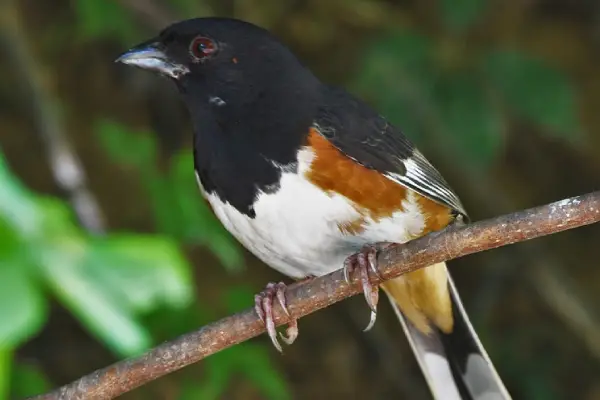
- Scientific Name: Pipilo erythrophthalmus
- Lifespan: up to 12 years
- Wingspan: 8-12 in
Eastern towhees are large and conspicuous sparrows.
They measure from 7 to 9 inches in length and span from 8 to 12 inches across the wings.
Eastern towhees have white bellies, rufous sides, and long dark tails with white edges.
Males are jet black above, white below, and have rufous flanks, red eyes, and white spots on their wings; females have brown heads, throats, and backs and white bellies.
Eastern towhees inhabit forest edges, overgrown fields and woodlands, and scrubby backyards or thickets of the eastern United States and southeast Canada.
They might be hard to spot as they love to stay in thick undergrowth but once you learn their song, you will recognize them with ease.
Eastern towhees are famous for their short, three-note “drink-your-tea-ee-ee” song that ends in a higher-pitched trill. They also have a sharp, loud “che-wink” or “tow-whee” call.
Eastern towhees are secretive birds that spend most of the time on the ground, foraging through leaves using both feet.
These black songbirds with white bellies nest on or close to the ground, usually under bushes or in brush piles.
They will have two broods per year with 2-6 eggs. The species is monogamous.
Eastern towhees are omnivores and their diet mainly consists of seeds, fruits, spiders, and insects.
Black Skimmer
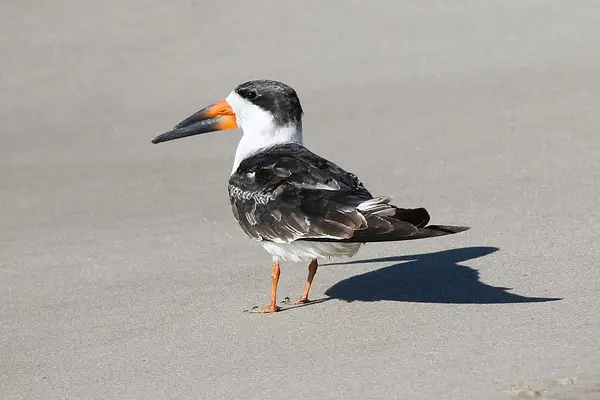
- Scientific Name: Rynchops niger
- Lifespan: up to 20 years
- Wingspan: 42-50 in
Black skimmers are large tern-like seabirds found in North and South America.
Adult plumage is a striking combination of black above and white below; together with the bright orange beaks, these birds are easy to spot.
Black skimmers have black backs and wings, white bellies and heads, dark brown eyes, and red legs.
During the non-breeding season, they become browner; identify them also by their barking “kak-kak” calls.
They are the largest of the three skimmer species and can measure up to 1 ft 8 inches in length.
Part of their scientific name “Rynchops” comes from the old Greek and means “cut-off bill” which describes these birds accurately.
Black skimmers have unique beaks where the lower mandible is longer than the upper; the base of the beak is orange-red while the rest is mainly black.
Such beak adaptation allows them to skim along the water surface and catch fish.
These black water birds inhabit rivers, coasts, and lagoons and feed there on small fish, insects, crustaceans, and mollusks.
Black skimmers are permanent residents of southern parts of the United States, Alabama, Florida, Louisiana, Mississippi, and Texas.
They are social birds that nest in colonies with up to several hundred pairs; both parents will take turns and incubate their 3-5 eggs.
Rose-breasted Grosbeak

- Scientific Name: Pheucticus ludovicianus
- Lifespan: up to 24 years in captivity
- Wingspan: 11-13 in
Rose-breasted grosbeaks are medium-sized songbirds with large triangular beaks, stocky bodies, short necks, and squared tails.
They breed in open deciduous woods of Canada and the northeastern USA and migrate to their wintering grounds in Mexico, Central, and South America.
They can be seen in the USA from spring to fall, anytime from April to September.
Male rose-breasted grosbeaks have black upperparts, white underparts, and rose-red upper breasts and underwings.
Because of such red color, people often call them “cut-throat” birds.
Females are brown and streaky.
Rose-breasted grosbeaks have a song that is a subdued mellow warbling and sounds like a sweeter version of the song American robins sing.
They also have a sharp “pik” call that resembles a woodpecker’s call.
They forage in shrubs and trees looking for insects, seeds, and berries.
Attract rose-breasted grosbeaks to your bird feeder by adding sunflower seeds, safflower seeds, and raw peanuts.
Red-headed Woodpecker
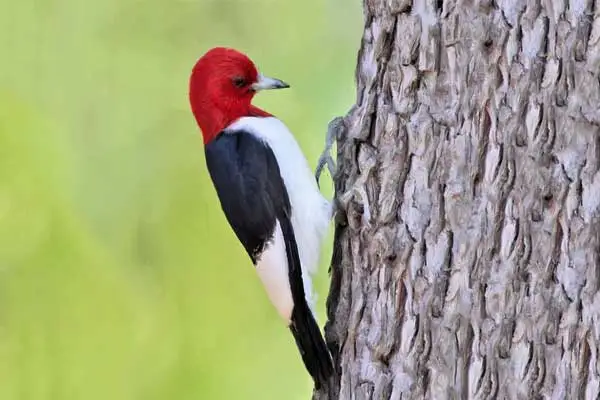
- Scientific Name: Melanerpes erythrocephalus
- Lifespan: 10-12 years in the wild
- Wingspan: 14-17 in
Red-headed woodpeckers are medium-sized woodpeckers commonly found around parks, forests, and woodlands of North America.
They breed across southern Canada and east-central parts of the USA from April to September, and around October migrate to their wintering grounds in southern parts of the USA.
Recognize these conspicuous birds by their black backs, white wing patches and underparts, white and unstreaked bellies, and brilliant red heads.
Males and females are almost identical.
Listen for red-headed woodpeckers’ slightly trilled “churr-churr-churr” call.
To catch the insects, red-headed woodpeckers will hammer at the tree bark, wait for them to come out, and catch them in flight; they might even hunt for them on the ground.
These birds are omnivores that also feed on seeds, fruits, berries, nuts, and occasionally small rodents.
Red-headed woodpeckers are cavity nesters and will have two broods per year with a clutch of 4-5 eggs; both parents will take turns in incubating the eggs.
Red-headed woodpeckers are one of the four species of North American woodpeckers that store food by covering it with wood or bark. They will stuff it in tree cavities, crevices, and under tree bark.
Eurasian Oystercatcher
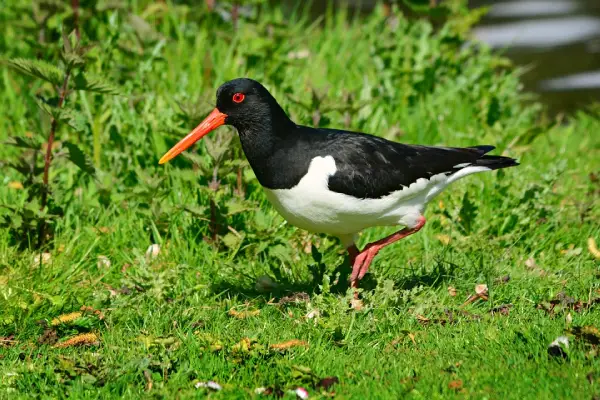
- Scientific Name: Haematopus ostralegus
- Lifespan: up to 40 years
- Wingspan: 32 in
Eurasian oystercatchers are known under several names, including the common pied oystercatchers, Palaearctic oystercatchers, and just oystercatchers in Europe.
These wading birds are found in Europe, Asia, and Africa.
Eurasian oystercatchers have black upperparts, white underparts, strong orange-red beaks, and red legs.
They are unmistakable in flight because of their white bellies and white patches on their wings and tails.
Eurasian oystercatchers are migratory; they breed in Europe and eastern and western parts of Asia, and winter in southern Asia and Africa.
They inhabit different coastal habitats, including beaches and mudflats, but can be also seen around nearby fields and inland.
During the non-breeding season, they will form huge flocks with hundreds of birds.
Identify these vocal and noisy oystercatchers by their shrill piping “kleep” calls.
Eurasian oystercatchers are carnivores and consume insects, insect larvae, bivalves, crabs, and earthworms; they use their long beaks to probe the mud and pry open shellfish.
Eurasian oystercatchers are monogamous and have a clutch of 2-4 yellow-brown eggs with dark spots.
Want to see examples of birds with black plumage that have long beaks? Check this article.
Barrow’s Goldeneye

- Scientific Name: Bucephala islandica
- Lifespan: up to 18 years
- Wingspan: 28-30 in
Barrow’s goldeneyes are medium-sized sea ducks that were named after Sir John Barrow, a famous 18th-century explorer.
Part of their scientific name refers to their unique-looking heads, coming from the Ancient Greek word “boukephalos” meaning “bullheaded.”
Adult males are mostly black and white, their dark backs contrast well with their white necks, breasts, and bellies. They also have bright yellow eyes and white spots near their black bills.
Females have a dark chocolate color on their heads while the rest of their body is grayish with a white underbelly. Their bills are mostly orange-yellow.
Despite being rather quiet, Barrow’s goldeneyes will make various sounds during their breeding season: low-volume squeaks, grunts, and croaks.
They breed in wooded lakes and ponds in northwestern parts of North America and some parts of eastern Canada and in Iceland.
These black and white ducks are migratory and will move to protected coastal waters or open inland waters of the northwestern USA during winter.
Barrow’s goldeneyes forage by diving and have a diet consisting of aquatic insects, crustaceans, and pond vegetation.
They are often found in mixed flocks with common goldeneye that they resemble – Barrow’s goldeneyes have more black on their backs, a purple sheen on their heads (not green), crescent-shaped (not circular) white patches on their faces, and shorter bills.
Barrow’s goldeneyes have a rather long lifespan – the oldest individual ever recorded had 18 years!
Atlantic Puffin

- Scientific Name: Fratercula arctica
- Lifespan: 20-30 years
- Wingspan: 19-25 in
Atlantic puffins, also known as common puffins, are small diving seabirds native to the Atlantic Ocean.
They have rather unique beaks; when viewed from the front, beaks tend to be quite narrow, but when viewed from the side, they are broad and triangular.
Identify Atlantic puffins also by their black bodies with white bellies, white faces, orange webbed feet, and colorful (red, yellow, and orange) beaks.
These puffins develop characteristical bright orange bill plates before the breeding season and shed them after breeding – when placed under UV light, Atlantic puffins’ beaks light up!
There are 3 subspecies of Atlantic puffins and one of the differences is their beak size; puffins living at higher altitudes tend to have bigger beaks and higher weight.
Because of suck parrot-like beaks, people have nicknamed them “sea parrots”.
Atlantic puffins are carnivores that feed on small fish like the sand eels, herring, hake, and capelin.
They are short-distance migrants and excellent fliers – puffins can flap their wings up to 400 times per minute!
White-necked Rockfowl
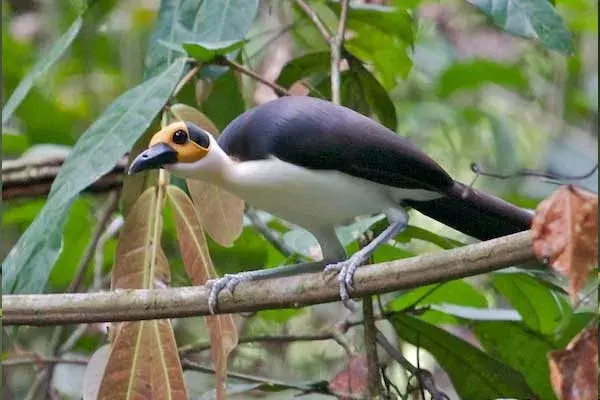
- Scientific Name: Picathartes gymnocephalus
- Lifespan: n/a
- Wingspan: n/a
White-necked rockfowls are also known as white-necked picathartes.
These medium-sized birds are commonly found in rocky forested areas at higher altitudes in west Africa, near flowing streams and rivers with access to wet mud for constructing their nests.
White-necked rockfowls are black and white; their upperparts are black, the underparts are white, their featherless heads are bright chrome yellow and black, and their necks and tails are long and used for balance.
Although mostly quiet, they will make some low clucking and other soft contact calls.
They are monogamous and pairs nest either alone or close to other pairs, sometimes in colonies with as many as eight nests.
White-necked rockfowls usually forage in pairs or groups on the forest floor and have a diet consisting of insects and some smaller frogs.
They are considered one of Africa’s most desired birds by birders and their population has been declining rapidly, with an estimate of fewer than 10,000 individuals in existence today.
Because of habitat loss, fragmented distribution, and mentioned population loss, the International Union for Conservation of Nature (IUCN) has listed them as Vulnerable.
Black-and-white Warbler

- Scientific Name: Mniotilta varia
- Lifespan: up to 11 years
- Wingspan: 7-9 in
Black-and-white warblers are medium-sized warblers with fairly long, slightly downcurved beaks and short tails.
They measure around 4.3-5.1 inches in length, weigh 0.28-0.53 ounces, and have a wingspan from 7 to 8.7 inches.
Black-and-white warblers breed in northern and eastern parts of North America and winter in Florida, Texas, Central America, and northern parts of South America.
Their breeding habitats include mature deciduous and mixed forests; during winter, they are common in a wider variety of wooded habitats.
If you are a beginner birder, these birds are a good choice, as they are easy to spot and recognize.
Their thin and squeaky song is one of the main ways to identify black-and-white warblers.
Listen for a high-pitched “wee-see” song that lasts about three seconds and is repeated around 6 times. Black-and-white warblers also have two calls, a hard “tick” and a soft, thin “fsss.”
Black-and-white warblers have black and white striped plumage with white bellies.
First to arrive at their breeding grounds are males that establish territories and later start searching for a partner. Their courtship rituals include following females around, singing, showing off feathers, and wing fluttering.
These birds can be very territorial and aggressive during their breeding season; like all warblers, they’ll attack and fight with other species that enter their territory.
Black-and-white warblers are insectivores (carnivores) that mostly feed on insects, caterpillars, beetles, ants, flies, bugs, and some spiders.
Common Loon
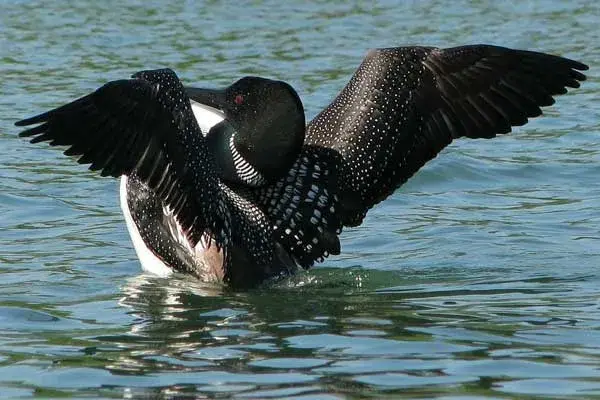
- Scientific Name: Gavia immer
- Lifespan: 20-30 years
- Wingspan: 50-57.8 in
These large diving waterbirds have rounded heads and dagger-like beaks.
During summer, adults are black above and white below: they have black heads and bills, white breasts and bellies, and black-and-white spots on their backs.
When the non-breeding season comes, the dramatic black and white colors will change into a winter plumage of dull dark gray with white on the front of their necks and breasts.
Common loons breed in Canada, northern USA, and southern parts of Greenland and Iceland.
After that, they migrate to their wintering grounds on both US coasts down to Mexico, and on the Atlantic coast of Europe.
During the breeding season, these black water birds are common on forested lakes and large ponds; during the non-breeding season, look for common loons on inland lakes, bays, inlets, and streams.
They are also known for their eerie, beautiful calls called the wail, tremolo, yodel, and hoot.
These excellent divers can stealthily submerge without a splash to catch fish, go over 200 feet below the water’s surface, stay there for up to 5 minutes, and swallow their prey underwater.
Common loons primarily feed on fish, crustaceans, insect larvae, mollusks, and occasionally aquatic plants.
They are monogamous and the pair may breed together for a decade or more. Both the male and the female will often together defend a territory.
Common loons are the state birds of Minnesota, provincial birds of Ontario (Canada), and one of 5 species of loon commonly found in Canada.
White-browed Wagtail
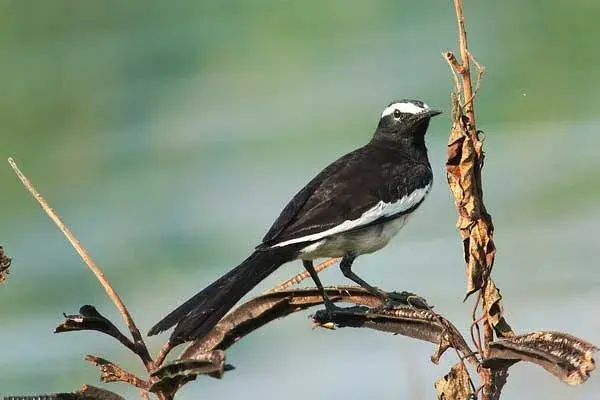
- Scientific Name: Motacilla maderaspatensis
- Lifespan: 2 years
- Wingspan: 12 in
White-browed wagtails, also known as large pied wagtails, are medium-sized birds with prominent broad white eyebrows.
They are the largest members of the wagtail family and measure around 8.3 inches in length and have a wingspan of 12 inches.
White-browed wagtails have black heads, backs, and upper tails, and white chests, bellies, and parts of wings.
These slender black birds with white bellies also have characteristically long and constantly-wagging tails.
White-browed wagtails have a long and loud song consisting of many different notes; their most common call is a wheezy “wheech“.
They are common around open freshwater wetland habitats.
Just like other wagtails, white-browed ones are insectivorous and feed on beetles, dragonflies, small snails, spiders, worms, crustaceans, and flies.
Part of their scientific name, “maderaspatensis” comes from the Indian city of Madras (now Chennai).
People used to keep white-browed tails as caged birds due to their amazing looks and singing abilities.
White-browed Fantail
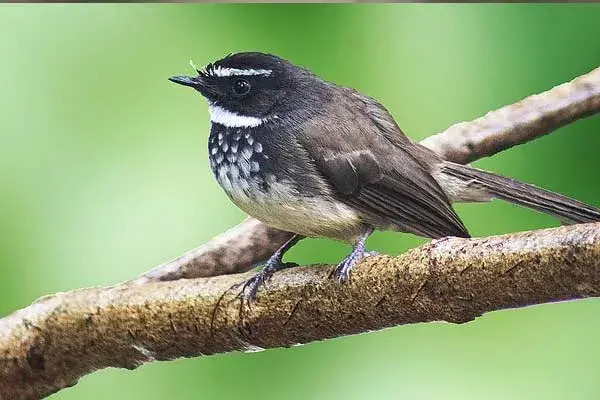
- Scientific Name: Rhipidura aureola
- Lifespan: n/a
- Wingspan: n/a
White-browed fantail is a small passerine bird found in Asia.
It breeds across tropical forests and woodlands of southern Asia, in countries like India, Sri Lanka, and Vietnam.
White-browed fantail is black with a white belly, chest, and undertail, it has a prominent white brow and a fan-shaped tail; this makes it easy to spot and identify in the wild.
The female has a slightly paler plumage and a browner head.
This black bird with a white belly has a melodious song that consists of 4-7 whistled notes and a harsh “switch-wich” call.
The species is insectivorous and has a diet consisting mainly of flying insects.
Rock Ptarmigan
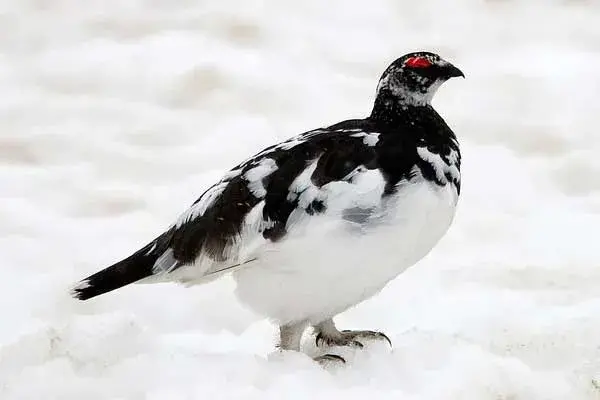
- Scientific Name: Lagopus muta
- Lifespan: up to 11 years
- Wingspan: 21–24 in
Rock ptarmigans are game birds found in North America, Europe, and Asia.
They are members of the grouse family and can be identified by their squared tails, small black beaks, and feathered legs and toes to walk in the snow and stay warm.
Breeding males have dark brown-black upperparts and white underparts.
When the winter comes, they become completely white to better blend with the environment.
Rock ptarmigans are common in northern parts of the USA; some populations can be seen in Washington during the non-breeding season.
Males are rather vocal and will emit different guttural snores and rattles, mostly when “fighting” other males during the breeding season.
They will also make rasping “ah-AAH-ah” calls at females as part of their courting game.
Rock ptarmigans forage on the ground and are omnivores. They consume plant buds, leaves, flowers, small twigs, berries, and seeds, but also spiders, insects, and occasionally snails.
Rock ptarmigan breeding males have scarlet patches (“combs”) above their eyes that resemble eyebrows.
Summary
This concludes our list of black birds with white bellies.
Examples of white-bellied black birds include several types of woodpeckers, warblers, puffins, penguins, ducks, magpies, and many others.
There is a vast number of animals that have a black and white palette and even more reasons for having such plumage/fur.
Some animals developed their high-contrasting markings as an evolutionary feature: black-white-coloring is a way to warn off predators, it might repel insects, or even create a clever disguise (as we saw with the brown creeper).
One of the reasons why birds might have them is courting – flashing their feathers might help them secure better partners.
Either way, the next time you see these birds, you will recognize any of them with ease!
And if you enjoyed our article, here are our other popular reads on birds: List of black birds that have yellow-colored wings and List of black birds that have long tails